Weber Piano Action Rebuild – Baby Needs New Shoes! (Err, Casters)
As I mentioned a couple of posts ago, the Weber had been without casters for about 20 years. After we moved to our log home, I was eager to make it more playable, but there was a distinct rattling! It took me a while to find the rattle, and it turned out to be the casters. Off they came. I wasn’t aware of piano geometry then, and although I noticed the keyboard was somewhat lower, it didn’t bother me. The old casters were stored in the garden shed and forgotten.
Now, with an action rebuild in process, it became obvious the extra bit of height was crucial not only for the player’s comfort, but also for the function of the pedals. Resting so close to the floor, they couldn’t be fully depressed.
Bernard suggested a new set, but at nearly $300, I hesitated. Then he mentioned some older casters that had been removed from other rebuilds — maybe some of them would suffice. We looked through the collection, and many had been removed for good reason. We did find one set of brass casters that looked pretty good though, and I could have them for considerably less. A little polishing, and they would look almost like new, and with the “modesty skirts” on the Weber’s Victorian case legs, most of the caster would be hidden anyway.
The first step was to clean up the “new” casters. The wheels were brass, but the rest looked like brass-plated steel. Comparing them with the old casters, I noticed a difference in size between the mounts. I would have to enlarge the hole in each leg. Using a cloth wheel and a little white polishing compound, they were gleaming in no time.
The next problem was removing each piano leg long enough to install the new casters. This is a heavier-than-average standard grand, and I was working alone. No problem — that’s what farm jacks are for. I had purchased a 48-inch jack thinking we could use it with our teardrop trailer, but it was simply too large and heavy. It was perfect for this job. I found a couple of scrap boards and blocks of wood to stabilize the farm jack base and protect the piano from its steel jaw.
It didn’t seem wise to rely on the farm jack while the piano leg was missing — I don’t really trust jacks of any kind. A substitute leg (a piano prosthetic?) seemed best. I have plenty of rough cedar 4-by-4 cutoffs, and the addition of a few long lag screws makes a very stout leg. I was ready for the lift.
Having never jacked up a grand piano before, I was cautious and took it slow. The farm jack made it very easy, and in a few minutes, one corner of the piano was several inches in the air. A few whacks with a rubber-faced mallet, and the leg was off. I positioned the substitute leg, and lowered the jack to share the weight. So far, so good.
The next problem was how to enlarge a hole and keep it perfectly round and centered. Bernard suggested plugging the hole with a piece of hardwood dowel and then re-drilling it. The only problem, 3/4-inch dowel isn’t available at the local home store. They do have 1-inch though. I would have to turn it down to the correct size.
Improvising with a “poor-man’s lathe,” I drilled a quarter-inch hole as close to the center of the 1-inch dowel as I could, and then installed a “T” nut in one end. A long, 1/4-inch bolt became the mandrel and an old 1/4-inch hand drill became the lathe. Mounted into a wood vise, I “turned” the dowel down to 3/4-inch using a wood rasp. A snug fit in the existing hole, and the 1-inch paddle bit centered up just fine.
The new caster mounts were a little sloppy in the new hole, so some thin shims snugged them up. After pre-drilling the four holes in the mounts, 2 and 1/2-inch wood screws secured them. I tapped the caster into the mount and the leg was ready to be remounted on the piano. One leg done.
The other two legs went together without incident, except space around the piano was tight. With the two grand pianos nested together, I barely had enough room for the farm jack. There was just enough though. The entire job took only a couple of hours.
And how did the piano do with all that moving and flexing? Not bad. A couple of notes detuned slightly, but not much. The Weber still has a very good and stable pin block. And best of all, the pedals were in the air enough to use. I could now align the hammers for the sotto voce pedal. Success!
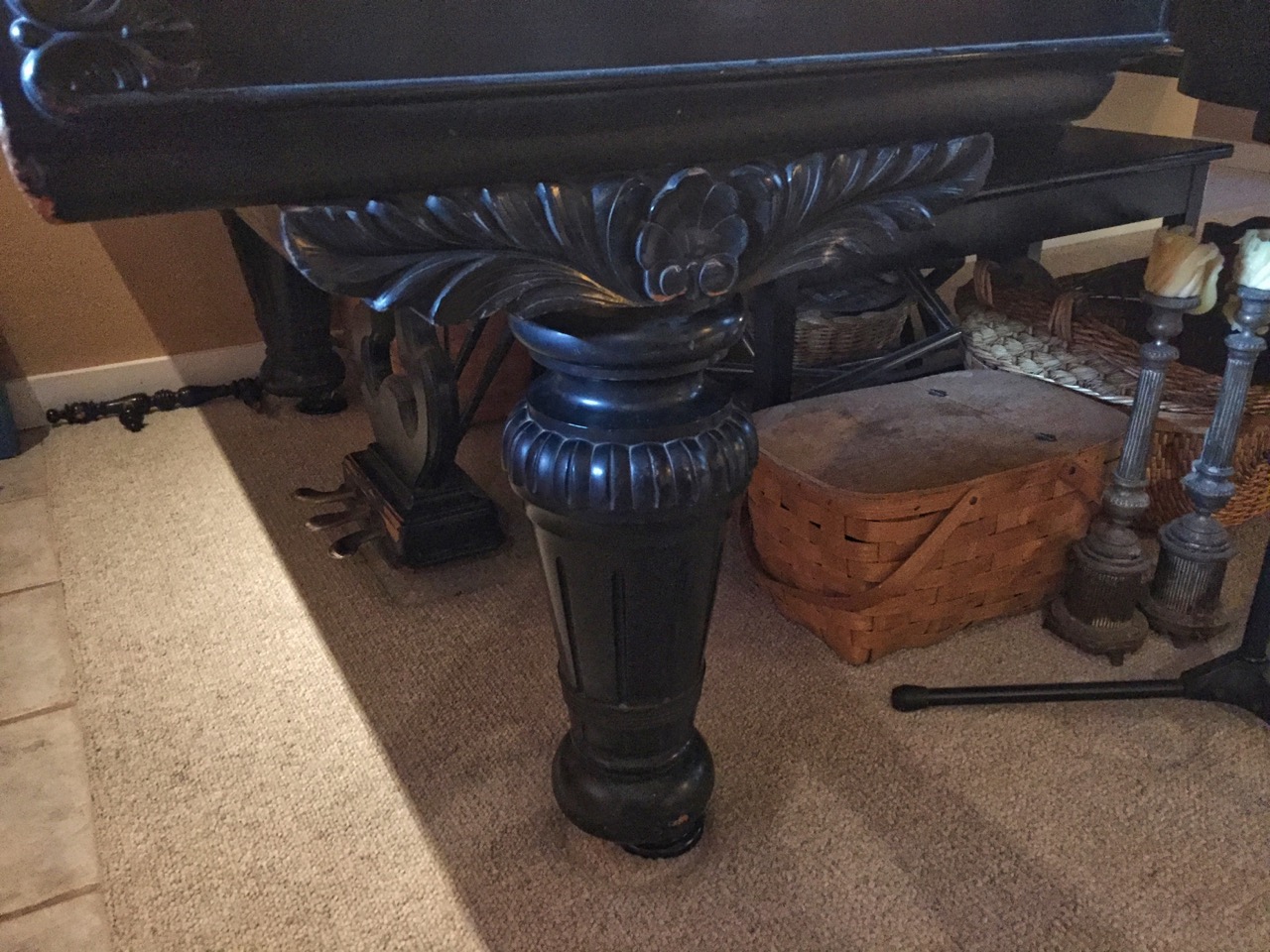
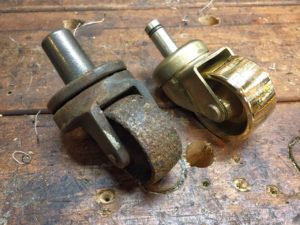
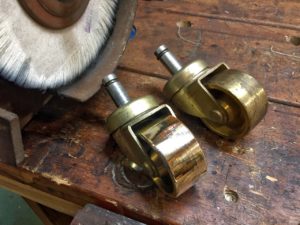
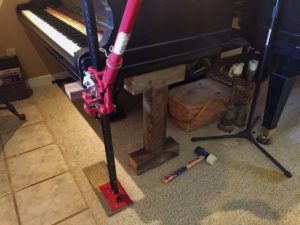









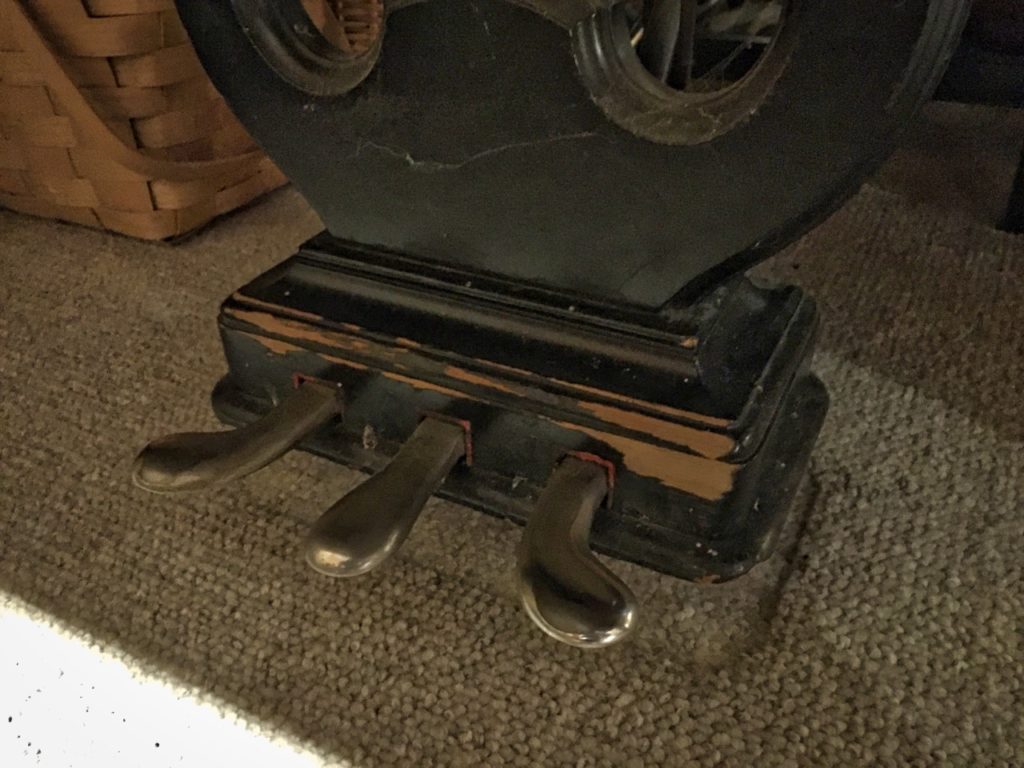
Pingback:Weber Piano Action Rebuild – RTFM | Roy Creek Ranch